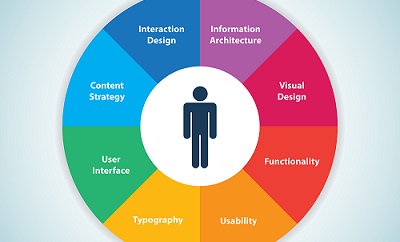 Early in the January 13 Chicago Interactive Design & Development session, Joo Serk Lee displayed the very first Amazon home page. “The website was hideous,” he said, “but the experience was amazing.”
Early in the January 13 Chicago Interactive Design & Development session, Joo Serk Lee displayed the very first Amazon home page. “The website was hideous,” he said, “but the experience was amazing.”
In his presentation, entitled “The Experience of Things,” Lee told attendees that there’s never been a more exciting time to be a designer. Or a more challenging one.
Lee, Vice President of Sogeti’s Digital Transformation practice, said that while designers have more tools at their disposal than ever, expectations have also never been higher. He emphasized, “There’s never before been so much emphasis on user experience.”
Humble Beginnings, Staggering Numbers
Lee’s brief history of our interactions with computing devices was amusing—and intriguing. Some highlights:
A Punch cartoon from 1907—depicting lovers more interested in their mobile telegraph machines than each other—uncannily foreshadowed the same scenario playing out 100 years later with billions of smartphones.
DEC debuted the mini-computer in 1960, but who could have imagined the possibilities for what Lee described as “the first input with live onscreen display”?
Despite its tank-like bulk, The Osborne 1 became the first portable computer in 1981, with a screen about the size of today’s smartphones. Of course, no one could have dreamed of the experiences we enjoy with those tiny screens today.
Or the volume—more than 268 billion app downloads, worth $77 billion, by 2017.
And that’s just for devices where we’ve always expected technological breakthroughs. The real frontier, Lee said, is in objects where we don’t.
The Internet of Things
Designers have plenty of challenges with today’s “conventional devices”—from giant screens and second screens to improved sensors and multiple inputs—but we’re only just figuring out how to create user experience with ordinary objects.
Welcome to the Internet of Things.
The Internet of Things refers to the transformation of everyday objects into data communication devices—smart cars, smart houses, wearable technology, even smart toothbrushes—that connect with us and each other.
Or, as serial entrepreneur David S. Rose says: “In an interconnected, instrumented and intelligent world, everyday objects become enchanted.”
But when even our toothbrushes are sharing data about us, how does that change our role as designers? Lee said we have to ask ourselves, “How do I craft an experience when I know so much about somebody? Who am I going to be—a creep, a carnival barker or a concierge?”
Mobile Moments
Lee said, “There’s a school of thought that says the ultimate goal of design is to create technology that the user doesn’t even know he’s using. It’s just there.”
On the other hand, we’re delighted by the “mobile moment”—a point in time and space when someone pulls out a mobile device to get what he or she wants immediately, in context.
“We’re the most impatient people in history,” he asserted. “The first time your phone told you that you had to leave now to make your next appointment because of heavy traffic—that’s pretty amazing.”
But now, mobile moments aren’t confined to phones and tablets. What about the smart umbrella that suggests you take it with you, because there’s rain in the forecast?
Security and the Streamlined Experience
Designers still have to wrestle with security and privacy issues, Lee said, no matter what new capabilities and platforms we develop.
“Security and a streamlined experience are inherently at odds,” he said.
Still, some designers foresee the development of a security experience similar to what comic book legend Thor enjoys with his hammer—it’s a potent tool for him, but a dead, useless object for everyone else. Your device would know—and only respond to—you.
But like airline passengers who demanded shorter waits even in the face of post-9/11 security measures, Lee said, technology users “care more about experience than we do about security.”
“We’re very demanding customers.”
Check out Joo’s presentation below:
You can also view the entire presentation on YouTube here.

WunderLand Group is your go-to partner for marketing, creative, digital and sales enablement service, and the employer of choice for creative and digital specialists.
© 2023 WunderLand Group